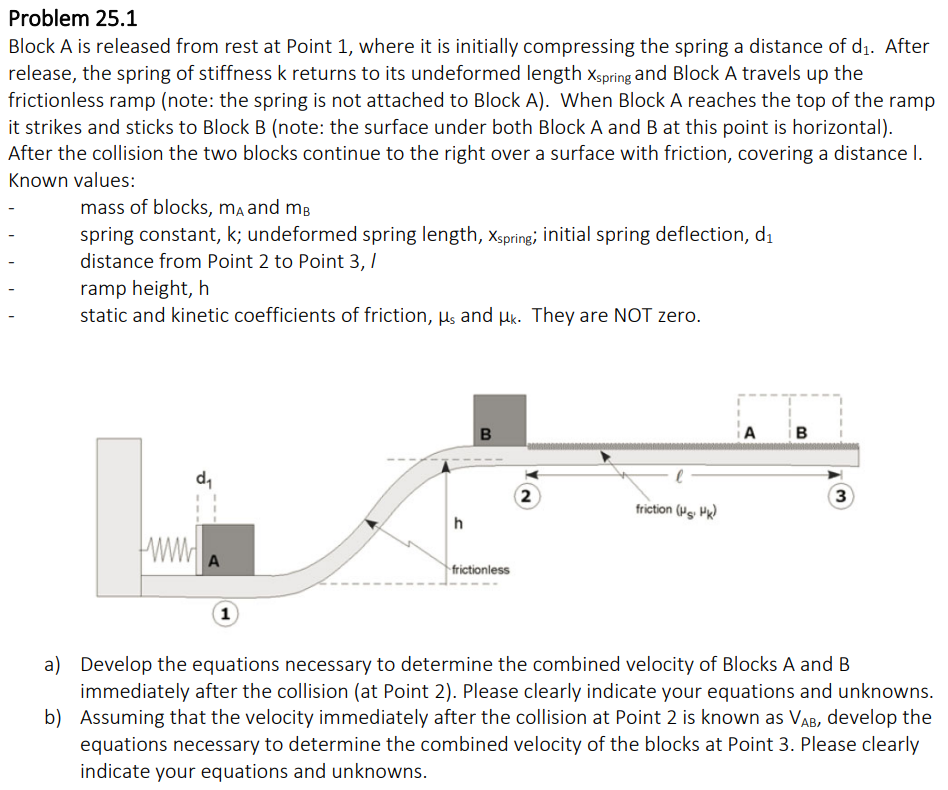Problem 25.1 Block A is released from rest at Point 1, where it is initially compressing the spring a distance of d₁. After release, the spring of stiffness k returns to its undeformed length Xspring and Block A travels up the frictionless ramp (note: the spring is not attached to Block A). When Block A reaches the top of the ramp it strikes and sticks to Block B (note: the surface under both Block A and B at this point is horizontal). After the collision the two blocks continue to the right over a surface with friction, covering a distance I. Known values: mass of blocks, mA and MB spring constant, k; undeformed spring length, Xspring; initial spring deflection, d₁ distance from Point 2 to Point 3, / ramp height, h static and kinetic coefficients of friction, µs and µk. They are NOT zero. www d₁ A h B frictionless 2 friction (HS: HK) A B 3 (1) a) Develop the equations necessary to determine the combined velocity of Blocks A and B immediately after the collision (at Point 2). Please clearly indicate your equations and unknowns. b) Assuming that the velocity immediately after the collision at Point 2 is known as VAB, develop the equations necessary to determine the combined velocity of the blocks at Point 3. Please clearly indicate your equations and unknowns.
Problem 25.1 Block A is released from rest at Point 1, where it is initially compressing the spring a distance of d₁. After release, the spring of stiffness k returns to its undeformed length Xspring and Block A travels up the frictionless ramp (note: the spring is not attached to Block A). When Block A reaches the top of the ramp it strikes and sticks to Block B (note: the surface under both Block A and B at this point is horizontal). After the collision the two blocks continue to the right over a surface with friction, covering a distance I. Known values: mass of blocks, mA and MB spring constant, k; undeformed spring length, Xspring; initial spring deflection, d₁ distance from Point 2 to Point 3, / ramp height, h static and kinetic coefficients of friction, µs and µk. They are NOT zero. www d₁ A h B frictionless 2 friction (HS: HK) A B 3 (1) a) Develop the equations necessary to determine the combined velocity of Blocks A and B immediately after the collision (at Point 2). Please clearly indicate your equations and unknowns. b) Assuming that the velocity immediately after the collision at Point 2 is known as VAB, develop the equations necessary to determine the combined velocity of the blocks at Point 3. Please clearly indicate your equations and unknowns.
Elements Of Electromagnetics
7th Edition
ISBN:9780190698614
Author:Sadiku, Matthew N. O.
Publisher:Sadiku, Matthew N. O.
ChapterMA: Math Assessment
Section: Chapter Questions
Problem 1.1MA
Related questions
Question

Transcribed Image Text:Problem 25.1
Block A is released from rest at Point 1, where it is initially compressing the spring a distance of d₁. After
release, the spring of stiffness k returns to its undeformed length Xspring and Block A travels up the
frictionless ramp (note: the spring is not attached to Block A). When Block A reaches the top of the ramp
it strikes and sticks to Block B (note: the surface under both Block A and B at this point is horizontal).
After the collision the two blocks continue to the right over a surface with friction, covering a distance I.
Known values:
mass of blocks, mA and MB
spring constant, k; undeformed spring length, Xspring; initial spring deflection, d₁
distance from Point 2 to Point 3, /
ramp height, h
static and kinetic coefficients of friction, µs and µk. They are NOT zero.
www
d₁
A
h
B
frictionless
2
friction (HS: HK)
A
B
3
(1)
a)
Develop the equations necessary to determine the combined velocity of Blocks A and B
immediately after the collision (at Point 2). Please clearly indicate your equations and unknowns.
b) Assuming that the velocity immediately after the collision at Point 2 is known as VAB, develop the
equations necessary to determine the combined velocity of the blocks at Point 3. Please clearly
indicate your equations and unknowns.
Expert Solution
This question has been solved!
Explore an expertly crafted, step-by-step solution for a thorough understanding of key concepts.
This is a popular solution!
Trending now
This is a popular solution!
Step by step
Solved in 4 steps with 4 images

Knowledge Booster
Learn more about
Need a deep-dive on the concept behind this application? Look no further. Learn more about this topic, mechanical-engineering and related others by exploring similar questions and additional content below.Recommended textbooks for you

Elements Of Electromagnetics
Mechanical Engineering
ISBN:
9780190698614
Author:
Sadiku, Matthew N. O.
Publisher:
Oxford University Press

Mechanics of Materials (10th Edition)
Mechanical Engineering
ISBN:
9780134319650
Author:
Russell C. Hibbeler
Publisher:
PEARSON

Thermodynamics: An Engineering Approach
Mechanical Engineering
ISBN:
9781259822674
Author:
Yunus A. Cengel Dr., Michael A. Boles
Publisher:
McGraw-Hill Education

Elements Of Electromagnetics
Mechanical Engineering
ISBN:
9780190698614
Author:
Sadiku, Matthew N. O.
Publisher:
Oxford University Press

Mechanics of Materials (10th Edition)
Mechanical Engineering
ISBN:
9780134319650
Author:
Russell C. Hibbeler
Publisher:
PEARSON

Thermodynamics: An Engineering Approach
Mechanical Engineering
ISBN:
9781259822674
Author:
Yunus A. Cengel Dr., Michael A. Boles
Publisher:
McGraw-Hill Education

Control Systems Engineering
Mechanical Engineering
ISBN:
9781118170519
Author:
Norman S. Nise
Publisher:
WILEY

Mechanics of Materials (MindTap Course List)
Mechanical Engineering
ISBN:
9781337093347
Author:
Barry J. Goodno, James M. Gere
Publisher:
Cengage Learning

Engineering Mechanics: Statics
Mechanical Engineering
ISBN:
9781118807330
Author:
James L. Meriam, L. G. Kraige, J. N. Bolton
Publisher:
WILEY